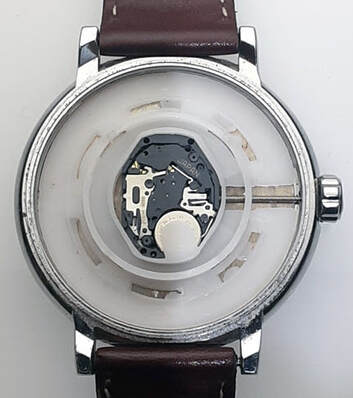|
Over the last 30 years or so of being in this trade, I’ve found it interesting to observe the trends of watches and their size, going from small to large and possibly reverting back to a more wrist palatable size… thank goodness! Back in the day, and I’m speaking of WAY before my time, a gentleman of the 1850’s could be sporting a watch (in his vest pocket) of generous proportions, measuring roughly 2 1/2 inches in diameter and ¾ inches thick. It is no wonder that somewhere along the line, these watches garnished the derogatory term of “turnips”. The bulge in the vest pocket was not quite so great as to elicit a greeting “happy to see you, too”...but these timepieces were robust, hefty and prior to the industrial revolution, mostly handmade. This was the style, manly. Long about 1915 or so, WWI ushered in a new era. Genuine ingenuity spurred on by chance, necessity or a combination of both, created the wrist watch. Prior to this, a man would not be caught dead wearing a “bracelet watch” as it would have been deemed far too effeminate. But in matters of war, one must risk masculine persecution in an effort to save one’s personal hide! So, ladies pendant watches were adapted to be fitted with a strap and could be worn by soldiers in battle more effectively than stuffing a turnip into one’s uniform trousers. On the wrist, the timepiece proved to be more effective and accessible. The above stylistic change was mostly, in my view, by necessity and less a product of public fashion whim. But what was also happening at the same time, was that the pocket watch was becoming more refined. This included stylistic and characteristic changes in the dimensions of the American pocket watch. Initially, the 18 size was the standard, with a case that weighed in at 2-4 oz. The new favorite was the 16 size and even 12 size (1915 era). Compare the difference of these two. The newer watches were becoming slimmer and more elegant. Elements of the dial graphics were changing too. Roman numerals and Arabic appeared to be almost equal in use, but Arabic was slowly taking over. Jump forward 40-50 years and pocket watch use was in decline. The wristwatch had become the timepiece of choice among the general public, who viewed the watch as a tool - not in the pocket but proudly adorning the wrist of a gentleman, refined and manly. They became slim, elegant and in some instances, offering more than just the time of day. As we approach 2020, I have come to observe over the last 30 years, that watch sizes have, on occasion, achieved proportions that could only be described as gargantuan; testosterone infused horological madness on the wrist. The worst part is, most of these oversized tire chain timepieces house nothing more than a dime sized quartz movement costing 1/20th the price of the watch! What’s more, the designers and manufacturers of these “timepieces” care little about the serviceability of their product. This is not to say that finer brands have not gone “big”. Even Rolex and other prominent brands have created oversized watches to follow the trend. And in some cases, I think they missed the boat. When I first opened the Last Wind-Up in 1990, nobody, and I mean nobody, ever asked “is this a 38 mm case or a 40?” This is something that I’ve only experienced in the last 10-15 years and it perplexes me. Please excuse the overtones, but if the watch looks and feels right on your wrist, what more do you need? I have a metric dial caliper if you need one. What you wear is a matter of your own personal taste. Men’s watches of the 1960’s and 70’s are now adorning the wrists of women. Men’s watches have grown and I predict that the proportions of these horological hockey pucks will diminish over time to a more “gender-neutral” size. In the end, it is what YOU want to see on your wrist that matters, and it is much more polite to look at your wrist than your cell phone. Call me old fashioned, but I am! Comments are closed.
|
AuthorArchives
May 2024
Categories |





 RSS Feed
RSS Feed